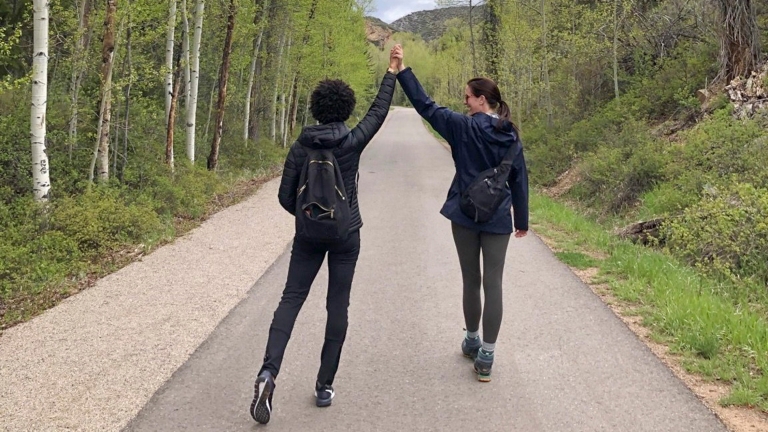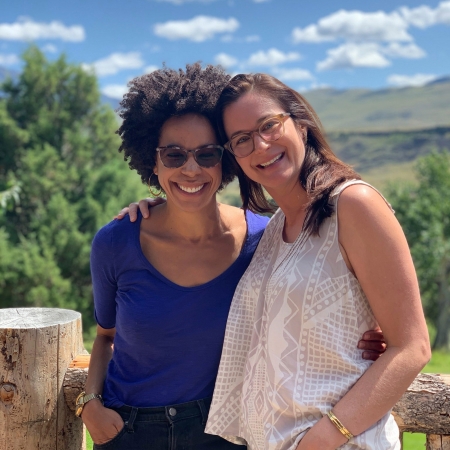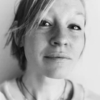All You Can Do
There’s so much. An interview with the co-editors of All We Can Save.
In September of 2020, Dr. Ayana Elizabeth Johnson and Dr. Katharine K. Wilkinson released All We Can Save: Truth, Courage, and Solutions for the Climate Crisis, a collection of essays, poetry and art with expertise and insights from women leading on climate solutions and activism in the United States. With the paperback release coming up on July 20th, we spoke to Ayana and Katharine about what’s changed, what hasn’t and must change, and how to still find joy while grieving.
This interview has been edited and condensed for clarity.
To start off, what’s changed since All We Can Save was first published?
Katharine: The first and most obvious thing is that we have a different president in the White House. So, our political landscape has dramatically changed. The book came out in late September of 2020 in the midst of now-President Biden’s migration toward being a climate candidate and then getting elected on, at least in part, a climate platform. Now we’ve got lots of questions about how that platform can or will come to life. But that certainly has been a very significant change. For the climate movement at a national level, it’s meant moving from, defense, defense, defense, to thinking maybe we actually have a really significant political opening for our movement in terms of federal climate policy.
Ayana: We’re also in this moment where people are trying to figure out what they want their new normal and the new normal to be. And I think this gives us a lot of ideas and inspirations for what it would look like to use this moment as an inflection point toward more care for nature and more sustainable ways of living on the planet.
The book includes essays by artists, writers, scientists and lawyers. Could you talk about the importance of a collective of voices versus one “lone hero” leading the way?
Katharine: I think the metaphor that I find myself using a lot is the metaphor of a kaleidoscope. Any single set of lenses on the climate crisis is insufficient. It’s when you start to have the layering of lenses and perspectives that you start to see things more clearly. And that’s how I think about the book. As you move through the various essays, poetry, art, it’s like another turn, another turn. And as you shift through this constellation of perspectives, you find yourself with a different level of clarity than you might arrive at when you read a book by a single author. It gives you more of a collective understanding and a collective vision of what is possible. And there’s almost a relief in that as well.
Katharine: There was a tweet recently from Beth Sawin, whose work we really love. I will paraphrase it probably slightly incorrectly: “Productivity hack: find your place in the work to create a just and livable future and do that with care and attention, trusting in the knowledge that unseen others are also playing their roles.” Some of that also gets embodied in the form of an anthology that you just don’t get from singled authored works.
Ayana: I don’t think this book would have had a fraction of the life it had if Katharine or I had written it independently or even if it was the two of us together, because there are a lot of climate books. But they don’t tend to inspire creative, forward-looking reactions in the same way I’ve seen with this book—where you’re presented with this cornucopia of ways to contribute and climate solutions in action and a beautiful and elegant place to be part of the solutions that we need. So, it really is like a smorgasbord of ways to be helpful. And you know, who doesn’t like a buffet? Katharine is bringing you the glorious artistic kaleidoscope metaphors, and I’m just like all-you-can-eat but for climate solutions.
I’m there for it! The All We Can Save, All-You-Can-Eat Buffet.
With the buffet analogy in mind, a lot of people, even those who are pretty engaged on climate solutions, are looking for that one big solution to fix it all. And obviously, the reality of the situation is that we need lots of solutions. An anthology is an amazing way to present that. But then how do we normalize that way of thinking?
Katharine: At a very basic level, people don’t know how incredible the cornucopia of climate solutions is or how deep and wide the toolbox of practices and technologies is. And that’s just if you’re looking at the things that actually reduce greenhouse gas emissions. Then you add in all of the leverage points for moving solutions forward, from shaping culture to changing policy, shifting capital, changing behavior. There are all of these other ways to intervene in the system. On the one hand, that can feel really exciting. And there’s a sense of relief of like, oh my gosh, there are so many things that we can do because we’re already doing them, just not at the scale that it’s needed to turn the tide. And also, it can feel overwhelming. But when we think about that toolbox, that cornucopia of solutions, it also adds to the sense that there are so many ways to help. None of us has to do it all. None of us could possibly do it all.
I love the line at the end of the book where you wrote that in some ways, we humans are not designed for this crisis that’s all encompassing, but in other ways, we’re sort of made for this moment.
Ayana: And in another way, we just don’t have a choice, right? We’re here. So what are we going to do?
I wanted to get into one solution that we’re excited about at Patagonia. We have been supporting grassroots environmental groups working on conservation, and especially in the past couple of years with groups who are working to protect 30 percent of the Earth’s lands and waters by 2030. It’s an ambitious goal, but we’re committed to it. But we’re also seeing people in our community who are worried about the impact of conservation on outdoor recreation. What would you say to folks who have these concerns?
Ayana: I certainly have sympathy for those concerns, but I also know that if we keep doing things as we’ve been doing them, that’s not going to work. There need to be some foundational changes in our collective relationship with nature. And to see it as a collective, beyond our species. We’re only one of 8 million or so species. And then I think it’s a moment for a deep kindness for people who are worried that the future might not have a place for them—because it is very scary to think about losing your livelihood or your source of emotional replenishment, which is what nature is for a lot of people.
So I think we need to proceed with shifts and with care and generosity, but we do need to change quite radically if we’re going to maintain not just a livable future, but a future that’s full of delights and enough food for everyone. And not just one extreme weather disaster following another. It’s very naive at this point to think we can keep on the way we’re going and make little tweaks, and somehow that will add up to enough.
How do you find common ground in these moments when you’re maybe talking to someone who is a skeptic or someone who doesn’t want to give up on certain conveniences?
Katharine: We have a tendency sometimes with climate to start from a place of facts, to start from a place like, you know, let me tell you this thing. Let me tell you this statistic, instead of starting from a place of, what is it that we care about as human beings? And oftentimes, one of the things we really care about is the place that we call home. When we start conversations from the connections that people already have, from the values that they already hold, the things they already care about, that can create openings.
Ayana: I don’t try to convince anyone anymore. I don’t think that’s my role. I don’t think that’s where I’m most useful. I can just share what I know and share what I learn. I’m just not going to spend my time arguing with people. It’s just very exhausting and draining. Or even like convincing and cajoling, because for me it feels like a waste of time. Like 80 percent of Americans are concerned about climate but haven’t figured out what they’re going to do yet, or where they fit in. So my focus, and the way that Katharine and I focus our work together, is not to win a debate but to say, we know you already care, let’s figure out what we’re going to do.
Katharine: What polling tells us is that the sidelines are very full. And so much of that work, just to echo Ayana, is about how do we welcome folks in a way that feels good and makes sense to them.

“One of the most incredible things about this planet is the determination and persistence of life,” says Katharine. Photo: Jennifer Robinson
It seems like sometimes the people that are sort of helping get others off the sidelines are the people you might never have heard of. In a lot of the conversations around climate advocacy, we often hear the same names over and over again. Are there people that you both know of who are doing really amazing work we might not have heard about?
Ayana: Also, there are people Katharine and I have never heard of who are doing incredible work. And I think that’s important in this moment. It’s not about a single hero. The list of people who could have written essays for this book just as women climate leaders in the US that Katharine and I already know is like well over 100. That’s just the people we could think of to put into a spreadsheet.
Katharine: There is some very real need to make noise. But often those become stories about individual people or even individual organizations. It’s really important to underline that the ability to make noise does not mean that quiet work is not really critical.
Ayana: Yes, we need leaders in every single community and every single sector. We have to transform everyone.
Why was it important to you that the book focus on women?
Ayana: Because that’s how we’d actually get it done.
Katharine: When we scan the landscape of voices shaping the climate conversation, shaping the zeitgeist, those have been predominantly, until very recently, white men and often a pretty small group of white men, actually. And we absolutely want them on the team. But that is not a whole team. And when people are only hearing from a very limited set of messengers, the subtext of that can be, this isn’t for me. I’m not welcome in this space. I don’t see myself here. Someone said recently that before they picked up All We Can Save, they felt like they had no role models on climate. And now they see there is this big community in which they feel like they belong. That feels really critical to this whole question of welcoming, inviting in.
Again, coming back to that kaleidoscopic perspective. That was really important for us: to use this collection as a bit of an intersession. One stone in the pond, really, but a way to try to recalibrate and find some more balance there.
There’s that line in the book about courage being the resolve to do something without the assurance of a happy ending. And both of you, at least outwardly, seem so eternally optimistic. How do you keep that with the work you do every day?
Ayana: It’s really important to distinguish between optimism and joy. I’m not an optimist. I’m firmly a realist. I don’t assume things are going to work out at all. I’m a scientist. I can see the graphs, and the trend lines are all going in the wrong direction. But just because I don’t assume we’re all going to live happily ever after doesn’t mean I can’t be happy in the moment and find joy in the work that I do, and find joy in collaborations and find joy in sharing in other people’s beautiful work.
So every time someone says, what brings you hope or what makes you optimistic, it’s like, nice try not using the word hope. It’s basically the same thing as optimism, and that’s so presumptuous. Why would you assume I’m optimistic? I feel an obligation to do my part. I really love getting to live on planet Earth. We need to hold a bit more of that complexity.
This is absolutely semantic, but I do like very much to hold on to possibility. That is a word that I hold on to and embrace. There is such a wide range of possible futures. I feel motivated and responsible to do my part to make sure we have the best possible one. I lean into possibility as opposed to any sort of assumption of a happy ending.
Katharine: One of the most incredible things about this planet is the determination and persistence of life. Life just keeps rumbling forward into more life. And when I feel hopeless, which I definitely feel sometimes, I think about this incredible life force that we are a part of that is our inheritance. And I hope will also be part of our legacy. I think the odds are long and the bar is high, and I would rather try for it than not.
And it sort of brings us full circle to the collective’s question, which is, if we are not ourselves people in serious positions of power, then how do we build collectives of power so that we are making better decisions than those handful of folks who have had an outsized say in what the future is going to look like for all people, and the rest of the beings that we share this planet with?
The complexity is the interesting part, that you can hold both things at the same time, the joy and also the concern. And that’s the drive to continue doing.
Katharine: And making the space to really let the grief go as deep as it wants to go or to feel it as deeply as it is actually present. For me, learning how to do that was really critical. Otherwise, I just found that I was like carrying this sort of rumbling malaise, depression thing all the time, as opposed to like just surrendering to the depth of it to be able to rise back into that place of courage and determination and possibility.
Join one or start your own All We Can Save circle—a gathering similar to a book club but for deeper dialogue about the climate crisis and building community around solutions.
Looking for the paperback edition of All We Can Save? It’s now available to order from your local bookstore.
Can’t get enough of inspiring climate solutions? Listen to Ayana’s podcast How to Save a Planet and Katharine’s A Matter of Degrees.


